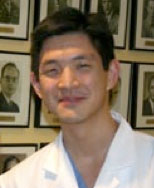The Next Generation
Lessons from the First Brigham "Lap Chole" in Training Future
Surgeons
 |
Eric Sheu, MD, PhD
|
By Eric Sheu, MD, PhD
PGY5, Department of Surgery
On February 22, 1990, in what is now a storage closet in the
operating room suites, the first laparoscopic cholecystectomy at the Brigham
was performed. Neither operating
surgeon had previously observed a laparoscopic cholecystectomy in person. They did not practice the operation in
a simulation center. Yet, the
operation was a success, and within a few months, 50 more "lap choles" were
performed here at the Brigham.
Twenty-seven years ago, the German surgeon Erich Muhe performed
the first laparoscopic cholecystectomy. The success of this operation sparked a
surge in the use of minimally invasive techniques in general surgery, reducing
the morbidity of many operations without compromising outcomes. The story of
the first Brigham lap chole illustrates the process of surgical innovation and
spread and offers some lessons on how we train our future academic surgeons.
In late 1989, the French presented a video of their laparoscopic
cholecystectomy at the SAGES meeting with a follow up publication in the Annals of Surgery. Interest spread
rapidly in the U.S., including at the Brigham with Dr. David Brooks and Dr. James
Becker. Brooks and Becker arranged to visit a surgeon at the University of
Maryland to observe him perform the operation. The first visit was grounded by a Nor'easter that closed
Logan. A rescheduled attempt was scuttled
when Maryland's chief of surgery bumped the scheduled case at the last minute
for his own urgent case.
The winter forecast must have been bleak, as Brooks and Becker
decided to sign up their first patient anyways. Brooks had watched several VHS videos of other surgeons
performing the operation. With that
preparation, they dove in. The operation took six hours, as they learned to
operate in a new two-dimensional
video-scopic world with relatively primitive instruments and optics. Nevertheless,
the operation and patient both fared well. News crews followed and soon
thereafter, patients were lining up for the procedure. By the year's end, Brooks was
performing virtually all of his gallbladders laparoscopically, and the staff
throughout the General and GI Surgery division were adopting the technique,
such that half of all the procedures at the Brigham were done laparoscopically.
Surgery's history is marked with similar forward surges as
surgical innovators pushed the border. Many Brigham trainees have led these
advances: Dr. Robert Gross, performing the first PDA ligation at Children's
Hospital while his chief was out of town; Dr. Robert Bartlett, taking ECMO from
the lab to bedside; and, of course, Dr. Joseph Murray, leader of the first
successful organ transplant. When you speak to Brooks today, he traces the confidence to try
that first lap chole directly to his training as a Brigham "super" chief, a
defining year spent after residency where one was responsible for all the ward
cases. Many former super chiefs
recount performing nearly 1,000 cases, of all types, in that single year.
Today, the trend in surgical training and practice is towards
earlier and greater specialization.
Studies suggest that higher volume surgeons performing the same few
procedures leads to improved patient outcomes. As this dogma spreads, general surgery is going out the
door, with fast tracking into specialties ascendant. After all, does a future cardiac surgeon really need to
spend years learning to remove gallbladders with a laparoscope?
Yet I wonder if the pendulum has swung too far towards
specialization. The broad training
of past years laid the foundation from which innovation sprung. Brooks, like other general surgeons,
first gained exposure to endo- and laparoscopic techniques while rotating in
gynecology as a resident. All surgeons have to learn new techniques and
operations through their career.
Many senior surgeons I speak with estimate that over half of the
operations common to their practice now, they had never seen, much less performed,
as residents. Is a narrow,
concentrated training best to prepare you to learn operations that don't yet
exist 5, 10, even 15 years out of residency on your own?
When Muhe finished that first lap chole just over a quarter
century ago, I doubt he anticipated the subsequent snowball of advances that
now define our modern operating room. I'm happy to say that I too can't quite imagine what cases
I'll be doing or what the OR will look like in 25 years. But as I enter this, my final year of
general surgery residency, I am confident that the Brigham has prepared my
classmates and me to tackle the new challenges that await us around the corner.